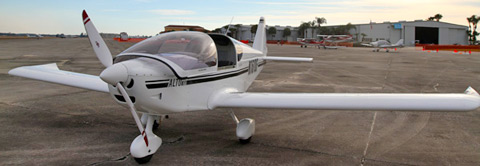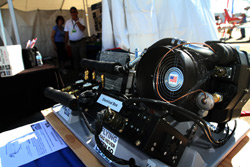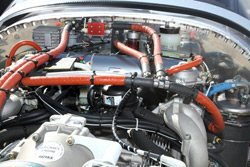
Docile is the word as the Alto 100 slows to a stall. And slows, and slows.
 The FlyCool air conditioning system, introduced at the Sebring U.S. Sport Aviation Expo, weighs in at 22 pounds and runs on a dedicated 70-amp electrical system, drawing only about half of that power. It is a first for the light sport market.
The FlyCool air conditioning system, introduced at the Sebring U.S. Sport Aviation Expo, weighs in at 22 pounds and runs on a dedicated 70-amp electrical system, drawing only about half of that power. It is a first for the light sport market.
At 2,000 feet msl, a few miles southwest of Sebring Regional Airport and the 2012 Sebring U.S. Sport Aviation Expo, Atlanta Sport Flight owner Paul Volle, a consultant for Ohio-based Corbi Air—importers of the Czech Republic-made DirectFly Alto—called attention to the declining airspeed. At 35 KIAS with flaps up, there was still no sign of buffet, and aileron control remained crisp and responsive. The Alto finally began to buffet, a barely perceptible buffet, at 33 KIAS, seeming to just hang there in space. With the electric-driven flaps fully extended, the Alto stalled at 23 KIAS, dipping the wing just slightly. Applying full power on the Rotax 912 ULS recovered the Alto to a positive rate of climb within two or three seconds.
Specifications – DirectFly Alto 100
Cockpit width: 43 inches
Wingspan: 26 ft 11 in
Basic empty weight: 710 lbs
Max takeoff weight: 1,320 lbs
Fuel, standard tanks: 24 gallons
Design load factor limits: +4g/-2g
V NE: 146 KIAS
V C: 100 KIAS
V LOF: 42 KIAS
Demonstrated crosswind: 15 kts
Takeoff roll: 361 ft
Takeoff over 50-foot obstacle: 1,126 ft
Landing roll: 354 ft
Landing roll over 50-foot obstacle: 1,201 ft
Glide ratio: 9:1
Range @ V C, 3,000 feet msl, 5,000 RPM: 4.2 hours, 454 miles with 45 min. reserve
Source: factory specifications
Making practice stalls a non-event was part of a design aimed at creating a “perfect” flight school trainer, and the Alto has many features designed to keep operating costs low and maintenance easy.
The wheel and brake assembly by Beringer includes long-life pads, and a modular design for easy removal and installation—they can be changed out in less time than it takes to jack the airplane, according to Dennis Corbi, who markets the Alto in the United States with his brother, Ron, out of Ohio-based Corbi Air.
Battery access is made easy through a side panel on the fuselage, just behind the wing. Engine fluid reservoirs are within easy reach under the cowling, and avionics can be accessed through a panel secured above and behind the instrument panel.
“You can change a radio in an hour without going to an avionics shop,” Volle said. “An A&P can do it.”
The bubble canopy, mounted on tracks to slide forward for cockpit entry, affords excellent visibility all around, and handholds allow for entry without stepping on the seat. The canopy’s slide mount reduces weight, contributing to a 610-pound useful load that is impressive by LSA standards. The Alto will remain within CG limits at all possible load configurations, and Volle said it is next to impossible to exceed gross weight, even with a full 24-gallon load of fuel.
 The engine compartment of the Alto 100 is arranged to offer easy access to fluid reservoirs and belts, reducing required shop time and lowering operation cost.
The engine compartment of the Alto 100 is arranged to offer easy access to fluid reservoirs and belts, reducing required shop time and lowering operation cost.
Aircraft-grade wiring, a stainless steel firewall, stainless steel control cables, a two-blade Sensenich propeller pitched for higher rpm, an electronic system that prevents the flaps from being lowered above V FE, and a lightweight air conditioning system offered as a $6,995 option, are also among the features and options designed to make the Alto friendly to both students and flight school operators.
“I’m trying to make everything perfect for flight schools,” Ron Corbi said.
Prices start at $104,498 for an Alto with a single Dynon SkyView SV-D700 EFIS/EMS, Garmin SL40 com radio, Garmin GTX 327 Mode C transponder, and PS Engineering PM3000 intercom. The $114,976 “pro-trainer” package includes dual Garmin G3X displays, an SL30 nav/com, Garmin GTX 23 ES Mode S transponder, lighting package, and panel-mounted compass. A $127,787 “cross-country” package adds a TruTrak GX autopilot and Garmin GMA 340 intercom with marker beacon to the mix.
 The Alto comes with a variety of panel configurations, and the bubble canopy offers excellent visibility on the ground and in the air.
The Alto comes with a variety of panel configurations, and the bubble canopy offers excellent visibility on the ground and in the air.
The Corbi brothers are working to arrange financing options that will assist with pre-delivery payments. The general unavailability of financing for flight school and leaseback purchases noted by many manufacturers at the Sebring expo remains an obstacle to sales taking off, but Volle said schools that commit the cash will be richly rewarded with a low-cost, dependable trainer.
For buyers with a bigger budget, a long list of additional options is available, including a $5,250 ballistic parachute system.



